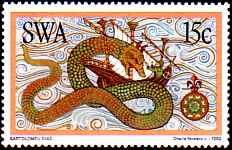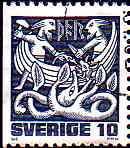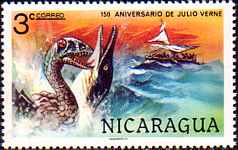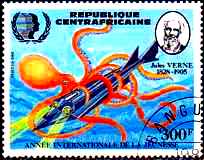
|
Maritime Topics On Stamps:
Monsters of the Sea,
Mythic Creatures!
|
|
For the holiday period we created a light-hearted page from the world of maritime stamps.
This page exclusively deals with sea monsters. Mermen and mermaids get their treat in a
coming holidays program.
|

| |
One can find sea monsters drawn on old sea charts again and again. It was common
practice to use them as fillers for the large unexplored areas. In addition, they
served to deter and obfuscate. Sailors, who had discovered a new route, wanted to
keep others away and made up terrible reports. The Portuguese even spread the rumor
that only the caravels built by them could defy the monsters. Every other ship would
have been pursued and devoured by sea dragons, giant fish, polyps etc.. These three
stamps show a section from a sea chart by Olaus Magnus (1539).
|

|
Many stories report sea snakes. For example in 1848 the watch-officer and the
captain of the British frigate 'Daedalus' observed an enormous serpent. It had a
pig's head, a horse mane and slid through the water at 12-15 knots. This report is
allegedly present in the records of the British Admiralty.
|
|
In 1734 the missionary of Greenland, a man named Paul Egede, reported a sea snake,
which rose so highly over the water that the head seemed to rise up over the the top
of the mast. This giant snake had a great snout, fins, scaly skin and blew water like
a whale.
|

|

|
Sea snake incidents were reported up to the end of the 19th century. In 1892 the
Dutch zoologist Oudemanns evaluated several hundred reports and came to the
conclusion that 187 encounters could be considered real. From the descriptions he
specified a seal- or snake-like mammal with a long neck and rudder tail.
|
|
In 1492 Columbus had many difficulties to recruit a crew for his discovery journey. The
seamen believed the frightening stories told in the taverns and refused his offers. For
example huge magnet mountains threatened to pull all nails from the ship. Terrifying monsters
lurked in the so-called 'sea of darkness' (the Atlantic), ready to devour ship and crew
alike. Columbus had to use official governmental pressure and exaggerated promises of
wealth to man his ships.
|

|

|

|
This is the sea horse of Petri Belloni from his work 'De Aquatilibus' written in 1580.
He called it 'Fabulosus Equus Neptuni' - the 'fabulous horse of Neptun'. A fact not commonly
known: Neptun was not only the Roman God of the sea, but of the race courses as well. Dolphins,
bulls and horses were regarded as holy animals. This horse is a combination of fish (tail and fins
under the hooves) and horse (torso and head). The Greek Sea God Poseidon fathered
the famous winged horse Pegasus. Pegasos is Greek for 'spring horse'. Thus the circle between
Greek and Roman mythology closes.
|

|
According to northern legends the snake Midgard lies hidden in the sea, enveloping the
whole known world. On the stamp to the left one can see a scene from the twilight of the Gods.
Loki, steering the ship 'Nagelfar', attacks the Asen, in the background the snake Midgard
helping him. However she will be killed by Thor (Donar), the God with the mighty
hammer (stamp to the right).
|

|
|
Waskos are mysterious sea wolves, which are hunting for whales. Once a Haida Indian saved
two small Waskos from starving. The thankful Waskos herded enough whales to the hunter
to supply his whole tribe. The legend tells that in the end the two Waskos were
transformed into two large rocks before the coast.
|

|

|

| |
The writer Jules Verne is known as the founder of the utopian-technical adventure
novel. He authored the legendary '20,000 Miles under the Sea', in which the submarine
'Nautilus' of captain Nemo is attacked by a huge polyp (depicted on the stamp to the
right). Verne also wrote the 'Journey to the Center of the Earth', in which a group of
researchers travelling on a raft on an underground ocean is confronted by sea monsters
(stamp to the left).
|

|

|
To the left you can see a painting of the Japanese painter Katsushika Hokusai (1760 - 1849).
It is named 'Whaling off Goto'. The lurking giant whale resembles an island from
far - a reminder of the legend of the Scottish abbott Brandan. In 545 Brandan sailed
to the west in search of Paradise. When he stopped on an island to read mass, he also lit
a fire. Suddenly the island began to move and the monks discovered that they were standing
on the back of a giant whale. They barely escaped (depicted in the Jersey stamps above).
|
|
Another Indian legend reports of a killer whale, which wanted to be depicted on a
totem pole. It seized an indian fisher and pulled him into it's underwater lair.
There the captive had to learn, how to paint killer whales and their dorsal fins.
Afterwards the whale led the indian back to the surface, and since that time,
faces of killer whales with large fins became a common sight on totem poles
and house fronts.
|

|

|

| |
Many myths originate in the Sargasso Sea, located approximately northeast
of the Caribbean Sea (see stamp to the left, the greenish spot around the red route
of Columbus). Here the Sargasso herb floats. Sometimes it grows so thick that one believed
that ships could become stuck forever. On the stamp to the right you can see a map of the
Seychelles. Right hand side a monster blows fountains like a whale. A flying fish
is depicted above.
|

|

| |
If you examine map stamps very closely, you can find ships and monsters again and again.
On the Swedish stamp cutout to the left you can see some spiny monsters,
a sea snake, a mermaid and a lobster. This again is a map of Olaus Magnus drawn in
1572. On the Icelandic stamp to the right Olaus Magnus painted a ray-like fish,
which, joined by four other fish, attacks a hapless swimmer (1539).
|

|
The sea monster of today bears the name 'Nessi' and lives in the Scottish Loch Ness.
A photography of Nessi was discovered as fake, still some persons state that they saw
it. An intensive investigation of the lake including powerful sonar devices was conducted,
but Nessi remained a secret. The 'Official Loch Ness Monster Exhibition' depicts Nessi as a
dinosaur, see stamp to the left.
|

|

|
In the end two facts:
- The Vikings often decorated the bow of their ships with a
dragon head (stamp to the left). This ornament served primarily to frighten opponents.
If such a head emerged from the fog, the enemy should assume a sea monster. A dragon
head was usually removable. If the boat came home it was dismantled because the good
spirits of the land should not to be frightened.
- A boat and its former occupants are sent whirling through the air by a mighty
tailfin (stamp to the right). This is to remind you, that there are indeed
enormous creatures in the sea, which can still be a threat to human life.
Note: Anyone who misses 'Moby Dick', can find him
on the literature page.
|
|